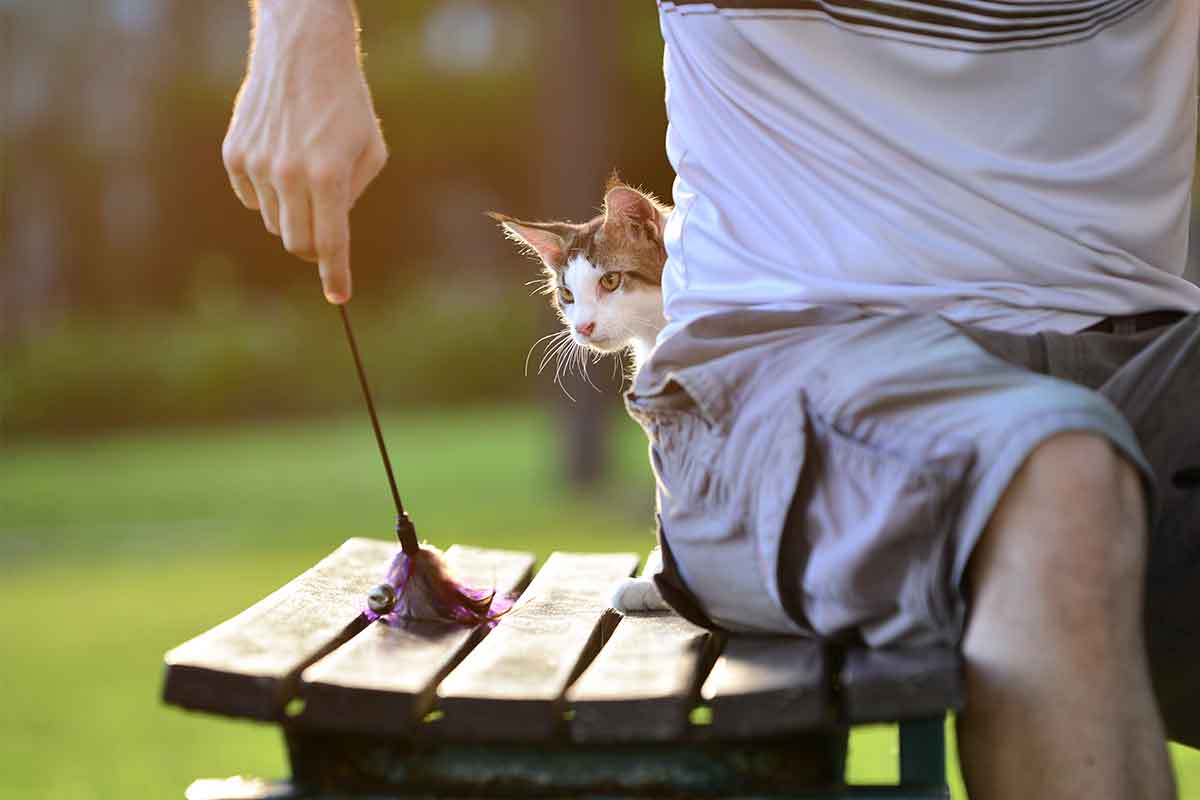If you’ve ever seen a litter of kittens zooming around in play, you know they bite and wrestle, jump on each other’s backs, and throw each other on the ground. They play rough. Flinging humans around is not an option, but young cats may nibble or bite our fingers, feet, or other body parts. They have a lot of energy and not a lot of self-control, and they can quickly become overstimulated and bite. It may be the one thing kittens do that’s not cute.
Young, healthy cats are hardwired to play. Play helps kittens develop social skills, motor coordination, and hunting skills. It helps young cats burn off excess energy. And some research suggests that it’s a self-rewarding behavior—in other words, cats just like to play.
If you have a mouthy, bitey kitten, don’t let her learn that it’s okay to play rough with you, even if her baby play is painless. The older she gets, the more it will hurt. Instead, set your kitten up for success by teaching her how to play nicely.
Play All Day
Young cats need a way to burn off energy, and that means a lot of interactive play. Try to schedule several play sessions throughout the day. It’s not enough to leave a pile of toys on the floor; cats need play with toys you make move, because nature has hardwired them to chase, grab, bite, and shake moving objects.
Those moving objects should never be any part of your body. Play using your hands, fingers, feet, or other body parts teaches kittens that body parts are to bite. And if it’s okay to bite your fingers when you wiggle them on the floor, you can’t expect her to know that it’s not okay to bite your fingers when you’re putting your shoes on. Give clear guidelines: Always bite toys; never bite people.
Make sure your kitten can catch and bite her toys often during a play session, because the bite is as satisfying as the chase. Use toys on poles, toys on strings, or soft toys you can toss. The idea is that play takes place far away from your body. Don’t touch your cat when she’s playing because she’s too excited.
Wind down play sessions slowly to give your cat the opportunity to calm down. Make the toy move less and less, like a wounded animal that finally dies. Finish with a treat (like a real hunt!) and then use a cue, such as “finished.” Use this cue every time and she’ll learn that it means playtime is over and will calm herself when she hears it.
Bite Your Toy, Not Me
You can teach your cat a cue to bite her toy rather than you. The key to teaching any cue is to use it consistently—the same cue, every time, in the same circumstances. Here’s how.
- When your cat takes any part of your body in her mouth, freeze. I know that seems counterintuitive; we instinctively want to pull away. But the more you move, the more you’re like a mouse struggling to get free and the harder she will bite down. Freeze and you are no longer so prey-like.
- When your cat lets go, slowly and calmly withdraw your body part and move away from her.
- Redirect her behavior by cueing her to “get your toy” and tossing a small toy her way, or picking up a wand toy and enticing her to engage with it.
Pay attention to your cat’s body language. Pet her only when she seems calm. If she’s excited, play with her. If you have a mouthy cat, pick up a toy before you start petting, because petting can start out calm and end up nippy. As soon as she starts to nip, use your “get your toy” cue and put the toy right in front of her mouth. Play with her with the toy, if you can do it without getting bitten. If not, leave her with her toy to play on her own, or grab a toy with a long wand so you can play from a distance.
Make sure family and visitors always use the freeze-withdraw-“get your toy” sequence when your cat bites. Sooner than you think, your cat will learn the cue, and you can use it to prevent a nip rather than respond to one. When you see her getting excited and reaching for you with her mouth open, say “get your toy” and offer her one. She’ll prefer it over you. Really!
Finally, if you adopt a pair of kittens, they’ll play together, using up all that energy, and teach each other the limits of physical play. When things get too rough, kittens can administer smack-downs and head-bops and other things that humans should never do (because we’re giants, not kittens). Plus, when you adopt a pair from the same group, they have a friend they know, which helps ease the stress of going to a new home and leaving littermates behind. If you already have a young, high-energy, nippy cat, adding a kitten as a playmate can work well. They’ll chew on each other and are less likely to nip you.
Beth Adelman, MS, is a cat behavior consultant in New York City. Beth is currently on the executive committee of the feline division of the Pet Professional Guild and is a frequent speaker on cat behavior.
This article was reviewed/edited by board-certified veterinary behaviorist Dr. Kenneth Martin and/or veterinary technician specialist in behavior Debbie Martin, LVT.








